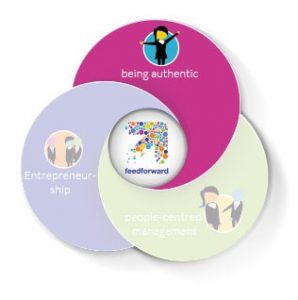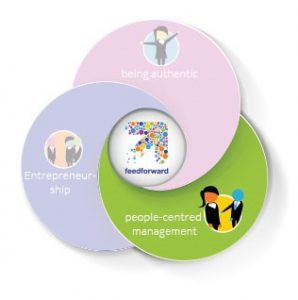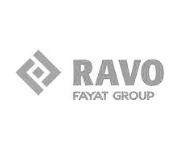The 48 qualities of excellent managers and leaders
The feedforward qualities and the three feedforward pillars were developed by means of a research project that consisted of two phases for determining the qualities of excellent managers and leaders from High Performance Teams and Organisations. The project included a literature review and an empirical study in the form of a global questionnaire, which will be concluded in the beginning of 2017. These qualities are the basis for the feedforward analysis™ and report.
The literature review
The literature review included the collection of available studies on excellent managers and leaders. The criteria that were applied were:
- The study is specifically designed to determine management and leadership qualities within High Performance Teams and Organisations or best practices.
- In order for the results to be generalised, the study has to include a questionnaire that is completed by a sufficient amount of respondents or comprehensive case studies from various organisations. The results should not be based on a single organisation.
- The study makes use of triangulation; applying more than one research method.
The study covers comprehensive documentation including a description and justification of the selected research methods, the research approach, and selection of the research population as well as a detailed description of the analysis and identifiable results and conclusions. Through that, the quality of the study can be assessed.
The literature review covered 112 studies that met one or more of the mentioned criteria. These studies formed the basis for determining potential management and leadership qualities within High Performance Teams and Organisations. Subsequently, these qualities formed the basis for the questionnaire that was applied in Phase 2. The studies were ranked according to thoroughness of research, ranging from ‘fully scientific’ to ‘based on my own experience’. The process of determining the qualities consisted of the following steps. Firstly, we selected those qualities that were indicated as highly important to excellent leaders and managers by the researchers. Secondly, these qualities were placed in a matrix. Not all authors use the exact same terms, which is why we first looked for similar elements in the studies which we subsequently translated into overarching categories. These categories were then translated into three feedforward pillars. A matrix was put together for each factor with its corresponding qualities.
Ultimately, 48 qualities of excellent managers and leaders were found:
Being authentic
An Authentic person is rewarded with authority and is appreciated for his / her honesty and fairness. They are  optimistic individuals who build trust and focus on improving individual- and team performance. They look closely at themselves and at the other individuals and are reflective by nature. Authentic individuals are decisive and result-oriented. The long-term result takes precedence over short-term profit.
optimistic individuals who build trust and focus on improving individual- and team performance. They look closely at themselves and at the other individuals and are reflective by nature. Authentic individuals are decisive and result-oriented. The long-term result takes precedence over short-term profit.
| Self-assertive | This individual is aware of his / her person, of his / her emotions, of his / her own behaviour and of the impact thereof. |
| Is self-confident | This individual is confident in terms of his / her own skills and competences. |
| Is reliable / honest | This individual is reliable and credible |
| He / she does what he / she says and says what he / she is doing. | This individual is congruent in word and deed. Verbal and non-verbal behaviour correspond. |
| Displays ownership | Takes responsibility for the development of the organization / the task. Feels a sense of involvement and ownership. |
| Is disciplined | Takes action, is devoted to it, and truly finishes what he / she started. |
| Puts things into perspective | Ability to put things into a broader perspective. Looks at situations in a relative manner, in proportion to other things. |
| Is modest | Does not place himself / herself, or his / her personal ambitions in the forefront. |
| Is humorous | Has an active, good-natured attitude in order to deal with situations. Herewith brings lightness and positivity. |
| Displays learning potential | Constantly finds new information and acquires new experiences and applies this on a daily basis. |
| Welcomes feedback | Is open to receiving feedback on his / her behaviour and actively seeks out acknowledgement (and recognition) of the feedback. |
| Focused on diversity | Actively seeks out the strength and added value of people with a different perspective. Gets different opinions and perspectives involved. |
| Displays decisiveness | Carries plans out fast and with vigour. |
| Pro-active | Thinks a few steps ahead, signals problems at an early stage, and takes appropriate measures immediately. Often takes the initiative instead of just following others. |
| Is resilient | Actively explores possibilities for dealing with a problem / negative experience and to get back on track. |
| Constantly improves | Constantly takes stock of the situation and is always aimed at improving the work. |
| Is optimistic | Frequently displays a positive attitude. |
| Can handle stress | Continues to perform calmly when work pressure is immense or in the event of unexpected setbacks. |
| Is flexible | Is able to adapt to unexpected or uncomfortable situations with relative ease. |
| Formulates and acts in line with common values | Is familiar with and converts the common values of the organization into actions. |
People-centred management
People-centred management gives employees energy. Colleagues feel heard and valuable. They see and feel that they  are being involved in the decision-making and efficiency in the workplace. By stimulating feedback, sharing knowledge and experience, and constantly maintaining contact with others, this manager stimulates the development of new ideas and he / she creates an environment of continuous improvement. This also results in a greater mutual understanding as well as better, more efficient decisions, in most cases. An individual with a people-centred management style is also able to establish unequivocal boundaries and is able to make individual decisions.
are being involved in the decision-making and efficiency in the workplace. By stimulating feedback, sharing knowledge and experience, and constantly maintaining contact with others, this manager stimulates the development of new ideas and he / she creates an environment of continuous improvement. This also results in a greater mutual understanding as well as better, more efficient decisions, in most cases. An individual with a people-centred management style is also able to establish unequivocal boundaries and is able to make individual decisions.
| Is people-centred and asks questions | Attempts to get to know the other person better by asking open questions. |
| Delegates based on strengths | Assigns responsibility to the other person, where appropriate, based on the individual’s potential and development. |
| Communicates clearly | Conveys information, ideas and objectives clearly and specifically. |
| Is decisive | Is resolute in terms of choices and decisions. Sets unequivocal boundaries through decisions. Dares to make choices, independent from others. |
| Conducts a dialogue | Is receptive to the other person involved in the dialogue (is a good listener) and follows the discussion with action. |
| Monitors | Assesses (evaluates) whether the right direction is being followed. |
| Expresses appreciation | Emphatically appreciates the involvement and added value of others. Gives compliments. |
| Gives feedback | Gives regular and direct feedback on the other person’s behaviour. |
| Coaches | Coaches others to reach better performance levels. Looks for the potential in people and stimulates them to improve their own performance levels. |
| Motivates and inspires | Inspires, motivates and stimulates others to perform exceptionally well and to do more than they ever thought possible. |
| Gets others involved | Gets others involved and allows them to contribute based on their strengths. |
| Stimulates connection and cooperation | Establishes synergy in a group of involved parties, stimulates mutual involvement in the group and motivates the involved parties to achieve effective collaborative efforts. This applies internally and externally. |
| Accepts the faults of others | Accepts the faults of others, learns from mistakes, and in so doing, stimulates progress and innovation. |
| Shares knowledge | Actively shares knowledge and in so doing enables the individuals and / or teams to apply the acquired knowledge at a later stage, in their own work situation. |
Entrepreneurship
Entrepreneurship is essential within an organization, in order to innovate and improve. A successful entrepreneur is able to link external developments to internal actions and promotes entrepreneurship amongst employees. He / she is able to mobilize ideas and to utilize them efficiently in the interest of the organization. A successful entrepreneur dares to take risks, but keeps the context and structure of the organization in mind during the process.
| Is focused | Sets and abides by priorities. |
| Has passion / positive ambitions | Believes in and is enthusiastic about reaching and achieving a positive goal. |
| Has a long-term vision and strategy | Keeps a clear eye on the ball and words / converts the objective into an appropriate strategy. |
| Is client-oriented | Always puts the client’s interests first (instead of his own interests). |
| Focused on results | Converts goals to results and focuses on achieving these effectively. |
| Is efficient | Employs an effective working method. Utilizes time, individuals and resources properly. |
| Puts the collective interest first | Puts the collective interest first, even ahead of his / her own interests. |
| Understands decision-making and the context of the organization | Understands how and when to successfully exert influence in the relevant work context. Is familiar with and has an understanding of the interests of others in this regard. |
| Mobilizes people | Actively gets people into movement. |
| Conveys a sense of timing | Has a good sense of when / when not to act. |
| Is prepared to take risks | Calculates the potential for risk and / or loss and makes a decision, also when success is not guaranteed. |
| Is creative | Has a creative capacity, is imaginative and inventive. |
| Focuses on the immediate vicinity | Knows his / her sector well and keeps his / her knowledge up-to-date. |
| Broad range of interests | Observes and actively learns from other branches / disciplines, societal developments and economic indicators. |







